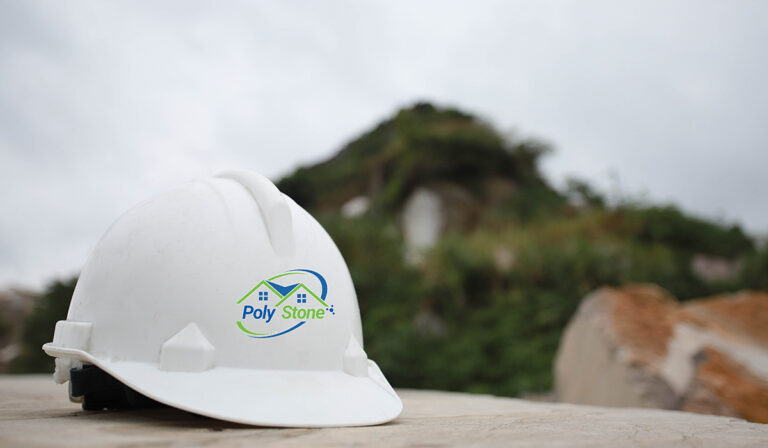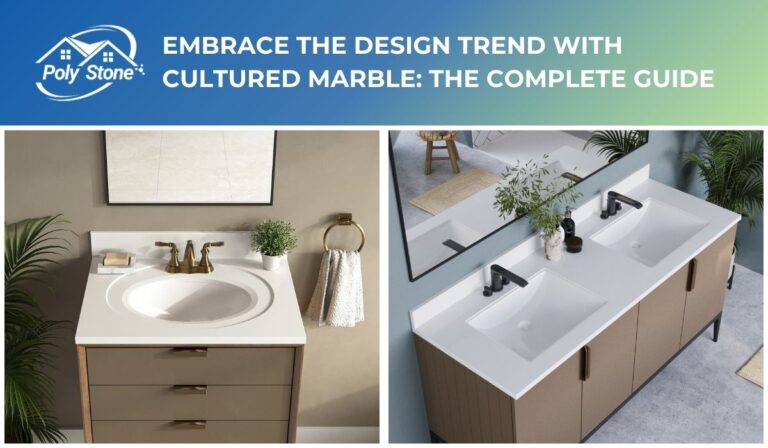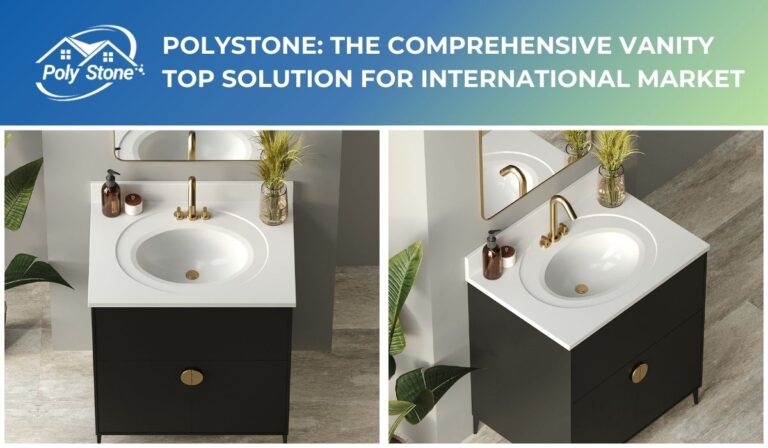Table of Contents
When planning commercial projects, selecting the right material for surfaces like vanity tops is a crucial decision. It impacts cost, aesthetics, and durability. Among the popular choices, Cultured Marble and Natural Marble are frequently considered. While both offer a luxurious appearance, they have significant differences in composition, properties, cost, and maintenance requirements.
Let’s dive into a detailed analysis to help you make the most suitable choice for your project.
1. Composition and Manufacturing Process
Understanding their origins helps clarify their inherent properties:
- Cultured Marble: This is an engineered material made from a mixture of crushed marble dust (limestone), polyester resins, and pigments. This mixture is poured into molds and often coated with a protective gel coat on the surface to provide shine and water resistance. This process allows for custom shapes and sizes, including seamlessly integrated sinks.
- Natural Marble: This is a metamorphic rock formed from limestone under immense heat and pressure deep within the Earth over millions of years. It primarily consists of calcite or dolomite. Natural marble is extracted in large blocks from quarries, then cut into slabs and polished to reveal its unique beauty.
2. Physical Properties and Durability
This is a key factor determining the material’s performance in a commercial environment:
| Property | Cultured Marble | Natural Marble |
|---|---|---|
| Porosity | Non-porous: Thanks to the gel coat, Cultured Marble has a non-porous surface, making it highly resistant to water absorption and stains. | Porous: Natural marble has a degree of porosity and requires periodic sealing to prevent liquid absorption and staining. |
| Durability | Medium durability: More durable than laminate but less than natural stone or engineered quartz. The outer gel coat provides initial resistance to chips, scratches, and stains. However, if the gel coat is deeply damaged, the underlying resin/marble dust mixture can be exposed and difficult to repair. | High durability: Very durable and can last for centuries with proper care. However, it’s considered a “softer stone” compared to granite or quartzite (Mohs hardness 3-4), making it susceptible to chipping if struck forcefully. |
| Scratch Resistance | Lower: The gel coat can scratch, and once a deep scratch penetrates it, it’s challenging to restore the original look without professional intervention. | Lower: More prone to scratches than harder stones like granite. However, minor scratches can often be buffed out or professionally repaired. Over time, marble can develop a unique “patina” from wear and tear, which many find appealing. |
| Heat Resistance | Poor: The resin and gel coat can deform, melt, or burn when exposed to high heat (e.g., hot styling tools, boiling water). | Excellent: As a natural material, marble possesses excellent natural heat resistance and is largely unaffected by high temperatures. |
| Stain Resistance | Good: Due to its non-porous gel coat, it’s generally resistant to most stains. However, prolonged exposure to certain harsh chemicals or staining agents can still lead to staining or damage to the gel coat. | Poor (if unsealed): Due to its porosity, natural marble is highly susceptible to staining if not properly sealed. |
| Etching Resistance | Good: Not susceptible to etching from acids. | Poor: Highly susceptible to etching from acidic substances (e.g., lemon juice, vinegar, coffee, wine). Acids react with the calcite in the marble, leaving dull, discolored spots. Sealing does not prevent etching. |
3. Aesthetic Differences
While both bear the “marble” name, their appearances have distinct characteristics:
- Cultured Marble:
- Appearance: Tends to have a uniform look; can sometimes appear “plastic-like” or “less vibrant” compared to natural marble, especially up close. It lacks the natural depth and variation.
- Color Consistency: High consistency, as pigments are controlled during manufacturing.
- Pattern Variations: Can mimic natural veining, but patterns are typically repeatable and standardized. A wide variety of colors and patterns are available due to artificial coloring.
- Customization: Highly customizable in terms of color, pattern, and shape. It can be molded into seamless units, including integrated sinks and backsplashes.
- Natural Marble:
- Appearance: Unique, luxurious, and elegant, featuring natural veining and subtle color variations. Each slab is one-of-a-kind, offering depth and natural vibrancy.
- Color Consistency: Inconsistent; colors and patterns vary significantly even within the same quarry due to natural impurities.
- Pattern Variations: Unique, unrepeatable natural veining and swirls.
- Customization: Limited to the natural variations of the stone. Customization involves cutting and shaping existing slabs, not creating new patterns.
Have a closer look: Step into our Cultured Marble Vanity Top Showroom
4. Maintenance Requirements
Maintenance is a crucial factor influencing the long-term cost of a project:
- Cultured Marble:
- Cleaning: Low maintenance. Use mild dish soap and warm water with a soft cloth or non-abrasive sponge. Avoid abrasive or acidic cleaners (bleach, ammonia, vinegar) as they can damage the gel coat.
- Sealing: Generally non-porous due to the gel coat, so sealing is typically not required. Some manufacturers might recommend periodic waxing for extra protection and shine.
- Repairs: Light surface scratches can often be buffed out with a wax polish. Chips or deeper scratches usually require professional repair, especially if they penetrate through the gel coat.
- Natural Marble:
- Cleaning: Requires pH-neutral cleaners specifically for stone or mild dish soap. Avoid acidic cleaners (vinegar, lemon juice) as they cause etching. Promptly wipe up spills.
- Sealing: Essential. Requires regular sealing (e.g., annually or semi-annually) with a high-quality impregnating sealer to prevent stains due to its porosity. Sealing does not prevent etching.
- Repairs:
- Etching: Mild etching can sometimes be repaired with marble polishing powder and buffing. Severe etching requires professional sanding, epoxy application, and re-sealing.
- Scratches: Can be buffed out or professionally refinished. Deep scratches may require professional help. Chipping can occur and might be repairable by professionals.
5. Cost Implications
Cost is often a primary consideration in commercial projects:
- Cultured Marble:
- Initial Purchase Price: Generally more affordable than natural marble, ranging from $30 to $100 per square foot (material only).
- Installation Costs: Can sometimes be higher per square foot than natural marble in certain comparisons, possibly due to the seamless, molded installation nature. However, the overall project cost might be lower due to the material’s lower price.
- Long-term Maintenance Expenses: Very low. No regular sealing costs. Simple cleaning. This contributes to better long-term value despite potentially higher initial installation cost.
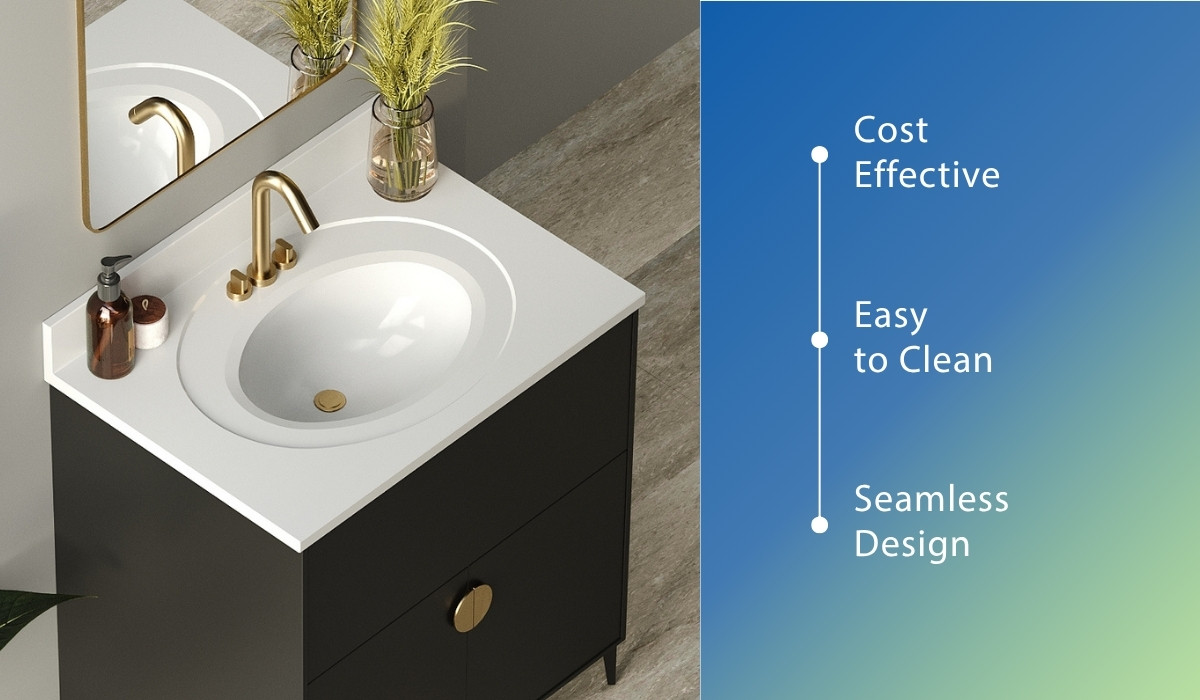
- Natural Marble:
- Initial Purchase Price: More expensive than cultured marble, ranging from $40 to $100+ per square foot (material only), with high-end varieties being significantly more.
- Installation Costs: Can be lower per square foot than cultured marble, but the overall project cost is often higher due to material price and the need for skilled installation.
- Long-term Maintenance Expenses: Higher. Requires annual sealing (with associated costs). Regular cleaning costs. Potential for expensive repairs if not maintained (e.g., severe etching, deep stains).
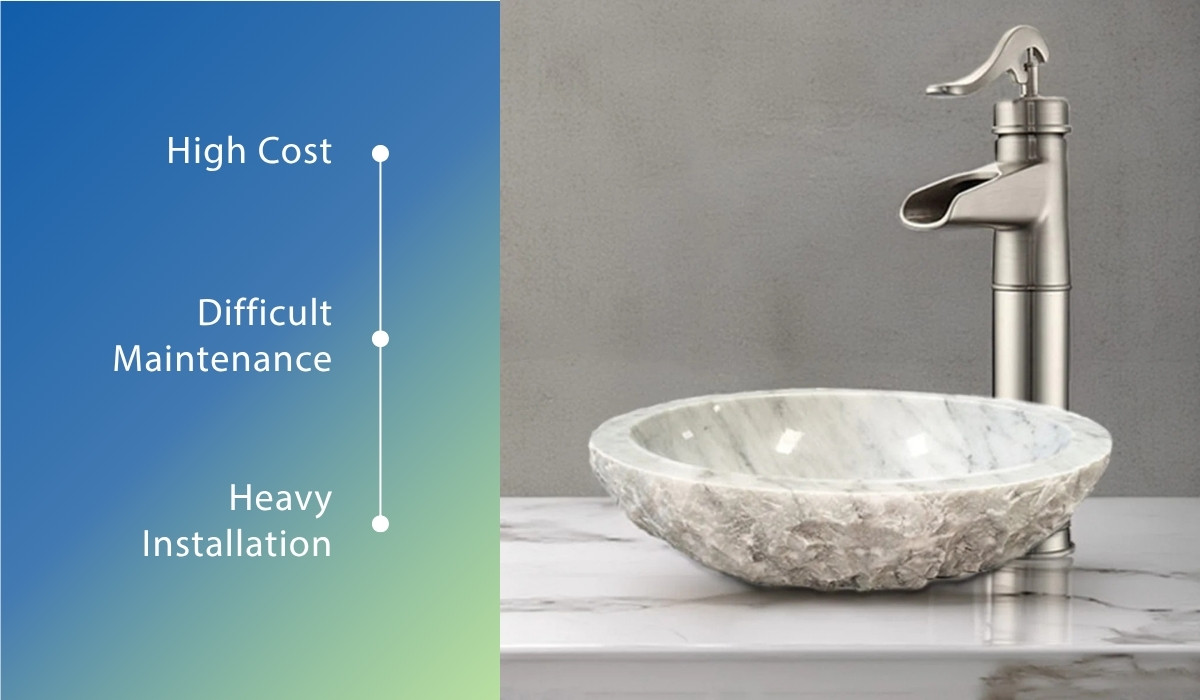
6. Lifespan and Longevity
- Cultured Marble:
- Typical Lifespan: Around 20 years.
- Factors Affecting Longevity: Proper care, avoiding extreme heat and abrasive objects, and maintaining the gel coat. UV exposure can cause yellowing if not UV-resistant.
- Natural Marble:
- Typical Lifespan: Can last over 100 years, even centuries, with proper care and maintenance.
- Factors Affecting Longevity: Regular cleaning, prompt spill cleanup, consistent sealing, avoiding grit, professional polishing/refinishing, and protection from physical damage (e.g., heavy impacts, standing/sitting on counters). The quality of the stone also plays a role.
7. Environmental Impact and Sustainability
- Cultured Marble:
- Resource Use: Utilizes marble dust/chips (recycled waste from natural marble quarrying), which helps reduce waste.
- Manufacturing Process: Involves synthetic resins and chemicals. Production can release Volatile Organic Compounds (VOCs) into the environment, contributing to air pollution. It requires considerable energy.
- Recyclability/Disposal: While both materials can be recycled, proper disposal practices are important.
- Natural Marble:
- Resource Use: Requires quarrying from the Earth’s crust, which has a significant environmental impact (habitat destruction, ecosystem disruption).
- Manufacturing Process: Cutting and refining are energy-intensive.
- Chemicals/Pollution: As a natural material, it does not release harmful chemicals or contribute to indoor air pollution (no VOCs from the material itself).
- Longevity: Its extremely long lifespan (centuries) significantly reduces the need for frequent replacement, which is a major sustainability advantage.
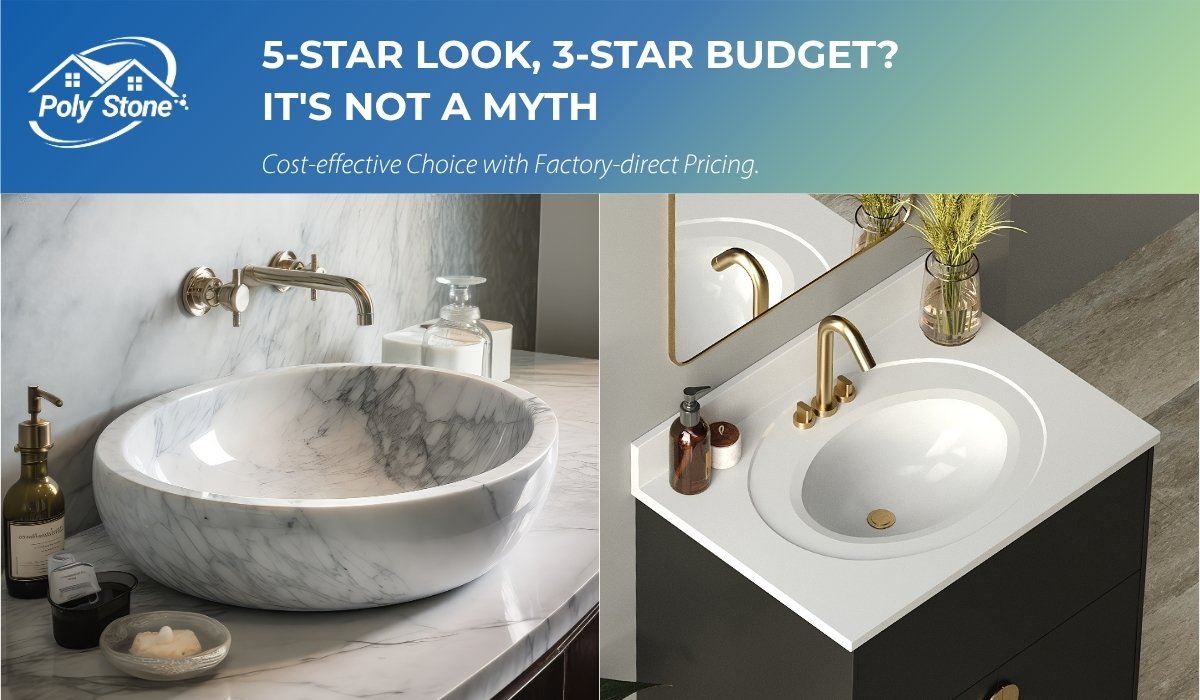
Let’s consider a hypothetical project: a 100-room hotel, with each room featuring a standard-sized vanity top.
| Cost Item | Natural Marble Vanity Tops (Estimated) | Cultured Marble Vanity Tops (Estimated) | Notes |
|---|---|---|---|
| Material Cost | $75,000 ($750/room) | $30,000 ($300/room) | Average price for a vanity top |
| Transportation Cost | $5,000 | $2,000 | Estimated overall cost |
| Installation Cost | $20,000 ($200/room) | $8,000 ($80/room) | Labor and time costs |
| Total Initial Cost | $100,000 | $40,000 | |
| Maintenance Cost (5 years) | $10,000 (Sealing, chemicals) | $500 (Soap & water) | Annual estimate |
| Repair/Replacement Cost (5 years) | $5,000 (Cracks, stains) | $1,000 (Minor scratches) | Estimated minor incidents |
| Total Cost of Ownership (5 years) | $115,000 | $41,500 | |
| Cost Savings with Cultured Marble Vanity Tops | $73,500 | Compared to Natural Marble Vanity Tops |
Export to Sheets
Case Study Conclusion: For a 100-room hotel, using cultured marble vanity tops can lead to savings of up to $73,500 in just the first 5 years, a significant figure for any investor.
PolyStone, is specialize in producing Cultured Marble Vanity Tops that combine elegant design with engineered durability – the perfect solution for commercial projects seeking both luxury and cost efficiency.
Why Choose PolyStone Cultured Marble Vanity Tops?
✔️ Custom-Made Designs – Tailored to your dimensions, and styles for seamless integration in hotel bathrooms and commercial spaces.
✔️ Consistent Quality – Manufactured under strict quality standards to ensure uniform patterns and finishes across large-scale orders.
✔️ Fast Production & Delivery – Leveraging Vietnam’s manufacturing strength to deliver high-quality products with competitive lead times.
✔️ Cost-Effective Solutions – Reduce your initial and long-term project costs without sacrificing aesthetics or performance.
While natural marble vanity tops undeniably offer unique beauty and luxury, cultured marble vanity tops emerge as a smarter and more efficient choice for commercial projects. With lower initial costs, optimized long-term operating expenses, coupled with superior uniformity, customization, and durability, cultured marble not only helps save budget but also ensures the quality and aesthetic appeal of your construction.
Considering these factors, what are the most critical priorities for your specific hotel project?
Get a quote for your project today and discover how cultured marble can optimize costs and enhance the quality of your construction!

